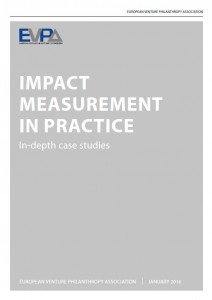For the past decade, as the importance of transparency and accountability within the philanthropy and social impact investment sector increased, impact measurement has moved from margin to mainstream, from too hard, to can’t miss. Today, many social sector funders measure their own broader impact as well as the impact of the grantees/investees they support. 
But measurement remains a challenge, with concerns over costs and resource intensiveness. Today EVPA launches two case studies which highlight two European organisations at the forefront of social impact measurement; Reach for Change and Investisseurs & Partenaires (I&P).
Working off the EVPA impact measurement framework, they show how the practical implemention of impact measurement can work within an organisation and that it can:
- Help funders devise an impact-centric investment strategy and implement an investment process in which impact is an integral component
- Reassure existing funders that their money is spent in the most impactful way, and convince them to reinvest while motivating new funders to get on board
- Demonstrate to investees and grantees the value of working with the funder
- Help investees/grantees manage their organisations to increase social impact
- Drive efficiencies, transparency and accountability within the funding organisations and the sector at large
Lisa Hehenberger, EVPA’s Research and Policy Director: ‘What these two case studies show is that, as a social sector funder, impact must be at the forefront of your investment strategy. It is your role to support your investees so that they can manage their organisations towards greater impact, which in turn will help you deliver on your social impact goals. This way, Impact Measurement is more than a framework or methodology, it is a strategic change in mindset.’
We are very grateful to Reach for Change and I&P for their openness around their learnings and challenges so as to ensure other practitioners can learn from them.
About the two case studies
Reach for Change is a grantmaker offering a five-year incubation programme to early stage entrepreneurs focusing on improving the lives of children. Ultimately driven by the need to assess performance among the social enterprises that it supports, Reach for Change started measuring impact in 2010. While they used to see it as a tool for the entrepreneurs they supported, over the years they realised the importance of using it to explain what Reach for Change is doing to its investors, to identify successes and failures in their strategy, and to take reinvestment decisions year on year.
Maria Modigh, Reach for Change’s HR, Institutional Partnerships and Governance and Legal Manager emphasised how ‘Applying an Impact Measurement approach to our Programmes has been a learning process from the very beginning. By consistently monitoring and evaluating our impact as an organisation we have been able to identify key learnings and use them to develop all aspects of our organisation, including our programmes, strategic focus and even the impact measurement process itself much more effectively and efficiently. In doing so, we have enabled our organisation to ensure all processes remain focused on what matters most to us at Reach for Change, creating social impact to improve children’s lives.’
Investisseurs & Partenaires is a 14-year old social impact fund focused on supporting – financially and through capacity building- small and fast growing African enterprises (including start-ups), with high social and/or environmental impact. Since its inception, I&P has invested in about 60 partner companies, based in 15 African countries, with annual growth rates of 24% in the investee companies. Since it started measuring impact, the organisation realised that, thanks to the definition of clear objectives and indicators, their work could be better monitored and improved and that it also served to align their team internally on their impact objectives.
Jean-Michel Severino, CEO of Investisseurs & Partenaires, commented: ‘Impact measurement is not about feeling good about what you did, it’s about learning about your activities and leaving things behind that others can reuse and scale.’
The case studies will be useful to all social sector funders- Venture Philanthropists or Social Impact Investors, but also foundations, grant makers, and social enterprises and non-profits seeking to understand how to practically apply impact measurement within their organisations.





Comments (0)